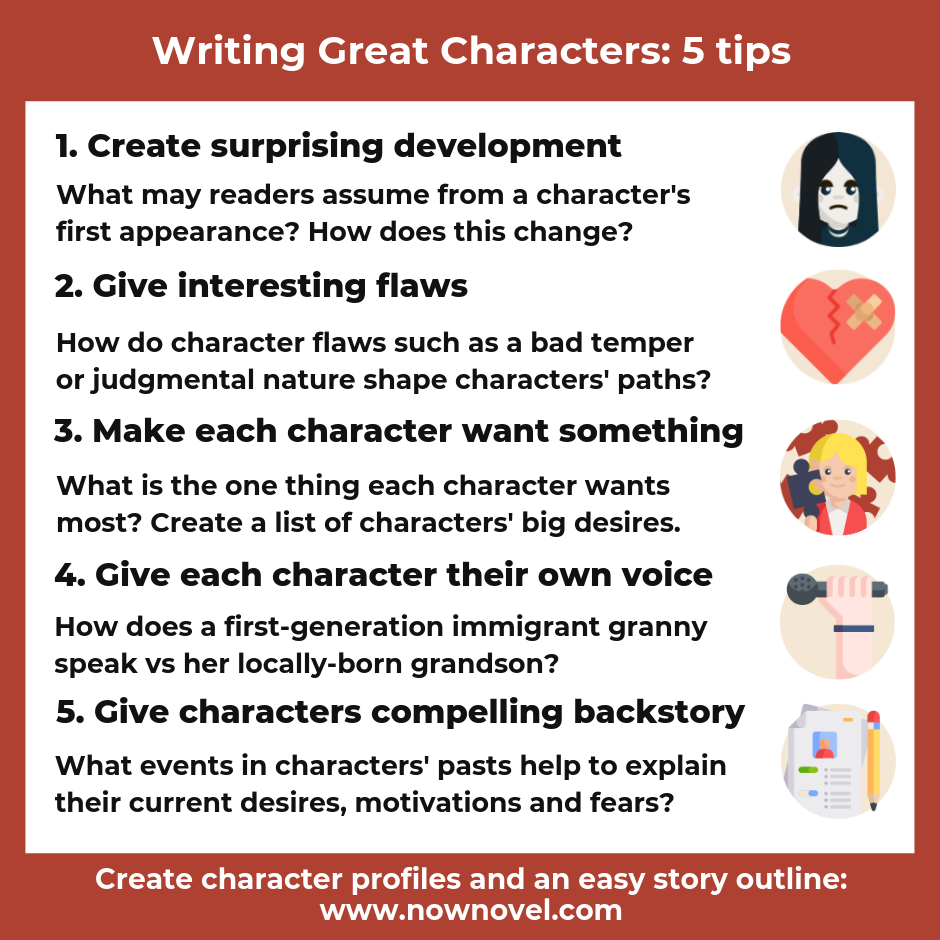If you want readers to fall in love with your novels, writing great characters is crucial. Read 5 lessons modern novels give us in writing vivid characters:
Lesson 1: Make characters surprise each other and the reader
Great characters often emerge in stages rather than all at once. Allow characters to surprise each other and your readers, too, with dramatic (but credible) changes.
Let's explore an example: Mr. Darcy in Pride and Prejudice. Although Jane Austen published Pride and Prejudice in 1813, it holds its own against more contemporary novels as an example of 'the modern novel'.
Surprise in character development: Mr. Darcy
Mr. Darcy, the protagonist Lizzie's eventual lover, is a classic example of a character who surprises us as the story unfolds.
Darcy at first appears to be aloof and proud. When we first meet Darcy at a ball, Austen shows this. The other attendees find Darcy 'disagreeable':
[H]e was looked at with great admiration for about half the evening, till his manners gave a disgust which turned the tide of his popularity; for he was discovered to be proud; to be above his company, and above being pleased; and not all his large estate in Derbyshire could then save him from having a most forbidding, disagreeable countenance...
Lizzie Bennet at first has a negative impression of Darcy too. Especially after she overhears him telling his friend Mr. Bingley he won't ask her to dance because she is 'tolerable, but not handsome enough to tempt me.'
By Chapter 6, however, Austen reveals Darcy's growing infatuation with Lizzie:
Mr. Darcy had at first scarcely allowed her to be pretty; he had looked at her without admiration at the ball ... But no sooner had he made it clear to himself and his friends that she hardly had a good feature in her face, than he began to find it was rendered uncommonly intelligent by the beautiful expression of her dark eyes.
Lizzie's dislike of Darcy, by comparison, at first intensifies. This is because it appears Darcy interfered in a budding courtship between Charles Bingley and Lizzie's sister, Jane. Yet in a lengthy letter, Darcy explains why he intervened. The more Lizzie (and the reader) sees of his character, the more his fair and thoughtful nature becomes clear. This produces a change in Lizzie's feelings ultimately.
Others misjudge Mr. Darcy based on partial information, and Lizzie (and the reader) realize the pitfalls of the 'prejudice' of the title.
This element of surprise and revelation makes Darcy a fascinating character. We see both how the character comes across at first encounter, and the greater subtleties of character beneath his his seeming coldness.
Lesson 2: Give characters interesting flaws
Writing great characters is impossible when all your characters are without fault. What makes us interesting are our contradictions, internal conflicts, our light and shade.
Characters' flaws contribute to a story in multiple ways. They create:
- Challenges and conflicts: A character who is arrogant, for example, will invite hostility from other characters
- Motivations and goals: Characters who are afraid of failure (for example) will likely push themselves harder to attain goals (for example athletic excellence). Their possible flaw (perfectionism) can thus also be a strong source of motivation
In Toni Morrison's novel Jazz (1992), the central character Violet Trace is nicknamed 'Violent' because she assaults the corpse of her husband Joe's mistress at the funeral. Morrison gives Violet common flaws of pride and vengeance:
She is awfully skinny, Violet; fifty, but still good looking when she broke up the funeral. You'd think that being thrown out the church would be the end of it - the shame and all - but it wasn't. Violet is mean enough and good looking enough to think that even without hips or youth she could punish Joe by getting herself a boyfriend and letting him visit in her own house.
Morrison, Jazz (1992), p.2.
Violet's flaws become character motivation for further actions. Violet carries out her need to vengefully reclaim power in various ways. She sets the birds her and Joe keep free through the windows 'to freeze or fly' (p. 1) and starts an affair of her own.
The flaw Morrison gives Violet makes her act out in interesting, compelling ways after Joe's betrayal.
Writing great characters means showing this cause and effect. Show readers how characters' behaviour impacts each other and draws out mutual flaws as well as strengths.

Lesson 3: Make every character want something
Writing great characters means making sure your characters have clear, credible motivations. It's like Vonnegut advised: 'Every character should want something, even if it's just a glass of water.'
Take Paula Hawkins' commercially successful psychological thriller, The Girl on the Train (2015). It's sold over 15 million copies worldwide in just two years.
How does a book become such a publishing phenomenon? For one, it needs riveting characters who have strong, compelling motivations.
In The Girl on the Train, Hawkins' protagonist Rachel Watson is a 32-year-old alcoholic obsessed with her ex-husband and his new wife, Anna.
Hawkins gives Rachel a clear motivation: The desire to hang onto her former life and its lingering passions and obsessions. After her marriage to Tom breaks down, Rachel becomes a full-blown alcoholic, causing her to lose her job. She keeps her routine, still catching the same train to London each day - it passes the house she and Tom once shared.
Rachel's repetitive behaviour shows a character in trauma who is unable to let go. Her former life and partner, taken together, are Vonnegut's glass of water, watched from a passing train. Rachel's motivation to linger and get attention drives her to more and more destructive behaviour, as she struggles to uphold any boundaries. She continually harasses Tom and his wife.
The character might be, as Hawkins described her, 'a mess who can't do anything right', but Hawkins makes her a controlled mess. Rachel's self-destructive actions propel the plot. They lead to dramatic encounters and consequences that pull intrigued readers closer.
Lesson 4: Give every character their own unique voice
Writing great characters also means mastering ensemble writing. In a multi-character novel, each cast member should stand out as distinct and real.
Take, for example, Jeffrey Eugenides' Pulizter-winning novel, Middlesex (2002). The novel follows the intersex Cal Stephanides (formerly 'Callie'), and their Greek family's history as immigrants to the USA.
In the novel, the voice of Cal, the narrator, is American - there is a clear sense of Cal's US-born, third-generation identity. The same goes for their father, Milton. Yet Cal's grandmother Desdemona's speech carries clear inflections of her Greek roots. Consider Desdemona's reproductive advice to Cal's mother, Tessie:
Why you want more children, Tessie?" She had asked with studied nonchalance. Bending to look in the oven, hiding the alarm on her face (an alarm that would go unexplained for another sixteen years), Desdemona waved the idea away. "More children, more trouble...
Eugenides, Middlesex (2002), p. 8
The way Desdemona talks (leaving out 'do' in 'Why do you want more children?') reveals her second-language English. Eugenides contrasts Cal's US-English voice as narrator is with their grandmother's Greek-English speech. This helps to create distinct character personas.
Each character's voice thus fits their background and backstory - the older generation retains a stronger sense of a nostalgic homeland in their speech. The younger US-born have perhaps less deep ties to these roots. Like Eugenides, use dialogue and narration to distinguish between characters' unique voices.

Lesson 5: Give characters compelling backstory
For your fictional world to be rounded and real, your characters should feel like they have pasts. You don't have to share every detail about their pasts. Yet there should be a sense of pre-history; context. Backstory, a character's formative experiences, explains (in part) why your characters have the goals and fears they do.
There are two cautions for using backstory:
- It's a minefield for character cliches
- Backstory should never overwhelm the main narrative arcs of your story.
On the first point: You've likely read at least one story where the protagonist has this backstory: orphan who, through fate, must save the world. This is particularly common in fantasy fiction.
J.K. Rowling makes this common cliche work for her, though, in Harry Potter. She makes the cliche her own by focusing on Harry's various forms of surrogate family.
We see Harry's mean adoptive parents as well as the alternative family he forms in his close friendships with peers and elders at school. His orphan status is thus not a relentless motif but rather one backstory element out of many. It doesn't overshadow the present narrative. Instead, Rowling uses her backstory to create contrast between
The oppressive, dull world of Harry's adoptive 'blood' relations and the 'chosen family' he finds away from them, in the magical world.
This strikes at a core lesson in backstory: Don't constantly remind the reader of it once you've established a character's past. Once we know Harry is an orphan, we don't need to be reminded of this formative aspect of his childhood every page.
Drip out backstory over the course of your novel. Revealing a character's past gradually is effective. It allows the reader to anticipate learning more about your characters.
Ready to improve your characterization skills? Join Now Novel and get helpful feedback on your characters from the community or your own writing coach.









"Lesson 4: Give every character their own unique voice." Yes, please. However, don't overdo. If you have a character who begins just about every sentence with "I mean," readers will want to choke you. Likewise with dialect. A tiny sprinkling enlivens dialogue like salt on a steak. Too much will make it come across as comedic.
Kathy Steinemann - Almost 8 years ago
Very true, Kathy. Thank you for sharing this vital caveat.
Bridget At Now Novel - Almost 8 years ago